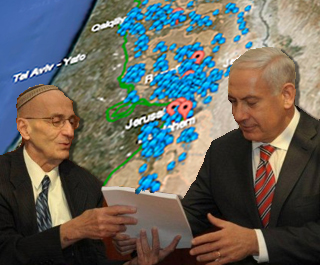Today’s New York Times features an op-ed by Dani Dayan, the head of the Yesha Council (the group that represents settlers and their interests). There isn’t really any news here: it shouldn’t surprise anyone that the settlers want the world to believe that settlements are good, peace efforts are pointless, and that the way forward should be premised on leaving all settlements in place, and leaving the West Bank under Israeli control, in perpetuity. Nonetheless, it is worth examining some representative snippets from this high profile op-ed.
 Washington, DC - Americans for Peace Now (APN) today joined its Israeli sister organization, Peace
Now (Shalom Achshav) in calling on the government of Israel to repudiate the findings of the commission it
appointed to address the problem of illegal outposts in the West Bank. APN calls on other US Jewish groups that
support the two-state solution to raise their voices in opposition to this report.
Washington, DC - Americans for Peace Now (APN) today joined its Israeli sister organization, Peace
Now (Shalom Achshav) in calling on the government of Israel to repudiate the findings of the commission it
appointed to address the problem of illegal outposts in the West Bank. APN calls on other US Jewish groups that
support the two-state solution to raise their voices in opposition to this report.
David Suissa wants us to believe that settlements aren't an obstacle to peace because their physical "footprint," their built-up area, represents "only" around 1% of the West Bank.
They agree that settlements are a problem, even a shonda, but boycott fellow Jews? Heaven forbid. And even if it weren't Jewishly distasteful, it wouldn't work anyway, so don't go there.
 Yesterday the Israeli government sent yet another signal that it when it comes to settlements,
rule of law is optional. It also gave another sign that this Israeli government prefers settlements to peace.
Yesterday the Israeli government sent yet another signal that it when it comes to settlements,
rule of law is optional. It also gave another sign that this Israeli government prefers settlements to peace.
The fate of Migron, an illegal outpost in the heart of
the West Bank, is about to be decided. The implications of this decision are about far more than the future of a
handful of settlers in a single outpost. This decision will be a litmus test of Israeli rule of law and,
ultimately, of Israel's capacity to make peace with the Palestinians.
How can one outpost be so important?
What is a settlement?
"Settlement" is the term used to denote Israeli civilian communities built in territory conquered by Israel in the Six Day War (June 1967). This territory is comprised of the West Bank (including East Jerusalem), the Gaza Strip, the Golan Heights and the Sinai Peninsula. These neighborhoods have been a major issue in the peace process since 1967 and remain highly controversial.
Settlements in the Sinai were evacuated and destroyed in 1979, following Israel's historic peace agreement with Egypt and the return of the Sinai Peninsula to Egypt.
Settlements in the Gaza Strip were evacuated and destroyed as part of Israel's unilateral "disengagement" from Gaza in 2005.
Therefore, today settlements only exist in the Golan Heights and the West Bank (including East Jerusalem).
This week Jerusalem mayor Nir Barkat will be in Washington. He will be holding meetings with Members of Congress, Administration officials, think tanks, and the press.
These interactions offer an excellent opportunity to hear the mayor's views about the Jerusalem-related issues of contention right now between his government and the Obama Administration.
To help prepare the mayor's Washington interlocutors for what will no doubt be a lively exchange of views, Jerusalem expert Daniel Seidemann and APN's Lara Friedman have assembled this guide to some of the most prominent - and inaccurate - assertions often heard about Jerusalem.
The background and details on the current controversy of a new settlement housing project green-lighted in East Jerusalem.